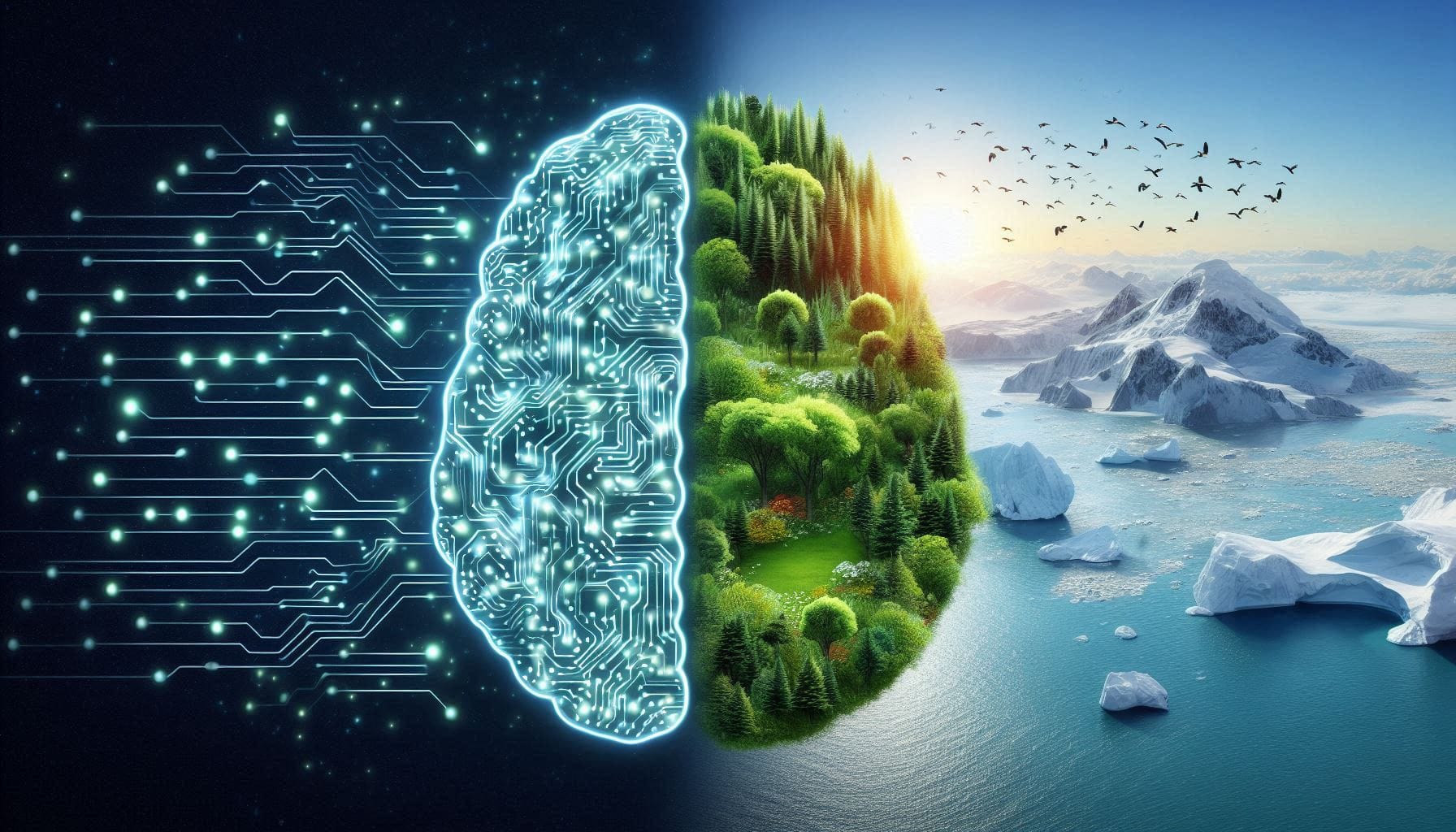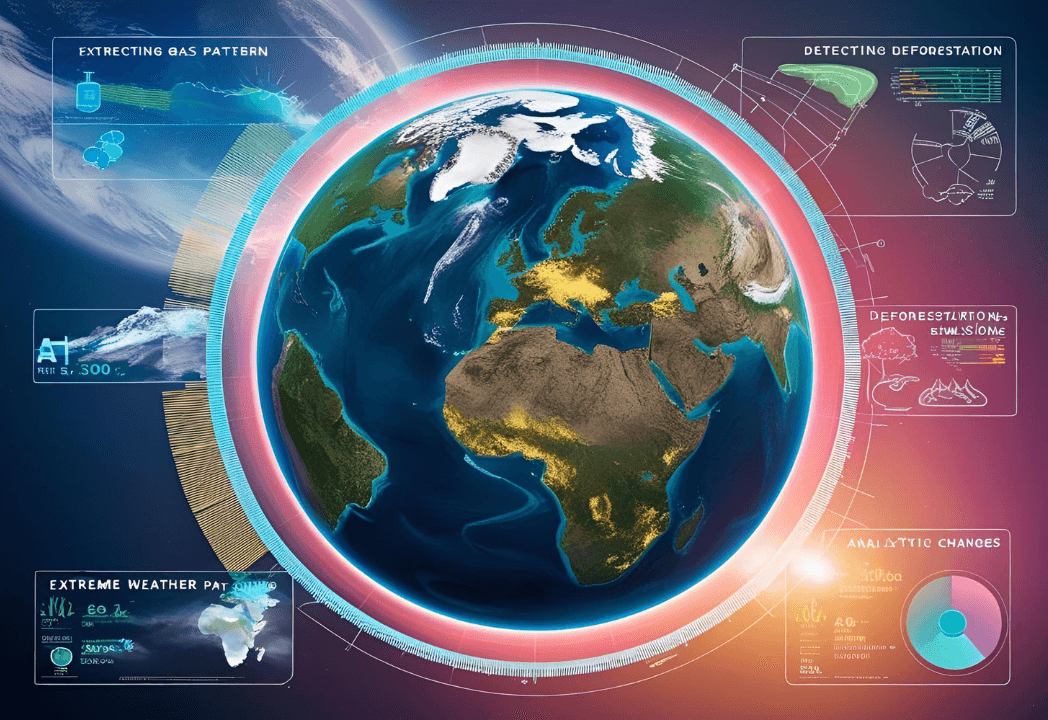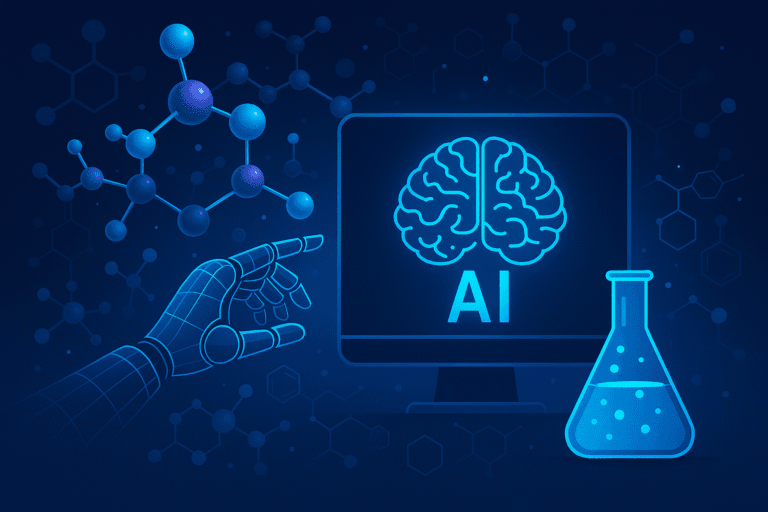Introduction: The Intersection of Technology and Climate Science
Imagine predicting devastating climate disasters weeks in advance — with near-perfect accuracy. That’s no longer science fiction. It’s the reality we’re stepping into, thanks to groundbreaking technologies like AI and supercomputers.
Climate change stands as the pivotal challenge of our time, and the opportunity to take decisive action is quickly closing. But where traditional tools fall short, modern technology steps in. At the heart of this digital revolution are AI in climate change solutions and supercomputers built for climate modeling. These innovations aren’t just improving our understanding of the climate — they’re actively shaping how we respond to it.

From forecasting extreme weather events to identifying patterns buried deep within decades of climate data, artificial intelligence climate solutions are offering scientists and policymakers new ways to act faster, smarter, and more precisely than ever before. And when paired with the raw computational power of supercomputers, we unlock the ability to simulate our planet’s future with unprecedented accuracy.
Understanding AI’s Role in Climate Science
In today’s climate science landscape, the volume of data we generate is staggering — from satellite imagery and ocean temperature readings to atmospheric carbon levels and ice core records. Traditional methods struggle to make sense of these massive datasets in real time. That’s where AI in climate change becomes transformative.
At the core of this shift are machine learning and deep learning algorithms — AI models that learn from historical climate data to detect patterns, make predictions, and even uncover hidden correlations that humans may miss. These systems are trained using decades’ worth of data, such as rainfall, temperature, greenhouse gas concentrations, and deforestation rates, to forecast everything from local drought risks to long-term global warming trends.
Unlike conventional statistical models, which require predefined equations and assumptions, AI thrives in complexity. It adapts, improves with more data, and identifies non-linear relationships in climate systems — something traditional models often overlook. For example:
- Neural networks have been used to reconstruct global temperature fields from sparse measurements with surprising accuracy.
- Random forest models can classify and monitor changes in land use and vegetation.
- Reinforcement learning helps optimize climate adaptation strategies based on real-time feedback.
One of the most compelling artificial intelligence climate solutions is AI-enhanced weather prediction. Tools like IBM’s Watson and Google DeepMind’s GraphCast are pushing the limits of accuracy in short- and medium-term forecasts — often outperforming standard methods. These improvements aren’t just academic: they save lives, help allocate disaster relief efficiently, and inform better climate policies.
Moreover, AI isn’t limited to predictions — it’s also a diagnostic tool. It’s helping scientists model the cascading impacts of climate feedback loops (like melting ice caps or forest loss), understand urban heat islands, and simulate “what-if” scenarios related to emission policies.
In short, AI in climate change is evolving from an experimental tool to an essential pillar of modern climate science. Its speed, scalability, and precision are redefining how we understand — and respond to — our changing planet.
Supercomputers: The Powerhouses Behind Climate Modeling
When it comes to understanding the future of our planet, raw computing power is just as critical as scientific theory. That’s why climate modeling supercomputers have become the unsung heroes of climate science. These machines don’t just crunch numbers — they recreate Earth’s climate systems in digital form, simulating decades, even centuries, of atmospheric and environmental changes in mere hours.
Contemporary climate models replicate the intricate dynamics between the oceans, atmosphere, ice sheets, ecosystems, and human influence. These models require calculations at resolutions measured in kilometers, over grids containing millions of data points, all evolving across time. This level of detail is far beyond the capabilities of standard computers — and that’s where high-performance computing climate science enters the picture.
One of the world’s most famous examples is Summit, developed by IBM and housed at Oak Ridge National Laboratory. Capable of 200 petaflops (200 quadrillion calculations per second), Summit has been instrumental in running high-resolution climate simulations that model everything from tropical cyclones to Arctic ice loss. It helped scientists explore how climate change affects extreme weather and even provided insights into the behavior of atmospheric rivers that cause severe flooding.
Another example, Fugaku in Japan — one of the fastest supercomputers globally — is being used to model the impact of climate change on public health and natural disasters across Asia. Meanwhile, Europe’s EuroHPC initiative is building exascale systems designed specifically to run next-gen Earth system models.
But it’s not just about speed — it’s about scale. Climate modeling supercomputers handle petabytes of data gathered from satellites, weather stations, and ocean buoys, running simulations of countless “what-if” scenarios. This helps policymakers and scientists visualize the long-term effects of different carbon emission pathways, guiding decisions on climate action with greater confidence.
Thanks to high-performance computing climate science, we’re no longer guessing how the climate might change — we’re watching those futures unfold in ultra-high-definition simulations. These powerful machines give us a clearer picture of how today’s choices will shape tomorrow’s reality.
Real-World Applications: AI and Supercomputing in Action
The fusion of artificial intelligence (AI) and supercomputing is transforming how we tackle environmental issues. Through advanced data analysis and predictive modeling, these technologies are providing actionable insights into deforestation, greenhouse gas emissions, and extreme weather events. Let’s explore some notable case studies that exemplify the tangible impacts of these innovations.
🌳 Monitoring Deforestation with AI-Powered Acoustics
In partnership with Rainforest Connection, Hitachi created a cloud-driven data intelligence platform that leverages real-time acoustic data to anticipate illegal logging activities before they happen. By analyzing sounds from the forest, the system can detect anomalies indicative of human intrusion, enabling proactive conservation efforts. (Social Innovation)
🌍 Tracking Greenhouse Gas Emissions with Climate TRACE
Climate TRACE is an initiative that combines satellite imagery and AI to provide independent, real-time tracking of greenhouse gas emissions across various sectors. By analyzing data from over 300 satellites and numerous ground-based sensors, the platform offers a transparent view of emissions, aiding policymakers and organizations in targeting their climate action strategies.

🌪️ Predicting Extreme Weather Events with AI
The MAELSTROM project, funded by the European High-Performance Computing Joint Undertaking, has developed AI-driven tools to enhance the prediction of extreme weather events. By integrating machine learning algorithms with traditional forecasting models, the project aims to improve the accuracy and lead time of severe weather warnings, thereby mitigating potential damages. (CORDIS)
🛰️ Satellite-Based Environmental Monitoring
Organizations like Farmonaut are leveraging AI and satellite imagery to monitor environmental parameters such as deforestation, crop health, and water resources. In Indonesia, for instance, AI-driven analysis of satellite data has enabled the identification of illegal deforestation activities, facilitating timely interventions.
These case studies underscore the transformative potential of AI and supercomputing in addressing environmental challenges. By harnessing vast datasets and advanced analytical capabilities, these technologies are not only enhancing our understanding of ecological systems but also enabling proactive measures to safeguard our planet’s future.
Challenges and Ethical Considerations
While AI in climate change and high-performance computing climate science are revolutionizing how we understand and respond to environmental threats, these technologies bring with them significant energy demands and ethical complexities that must not be overlooked.
⚡ The Energy Dilemma of Climate Tech
Central to the issue is the carbon footprint associated with operating advanced AI models and supercomputers. Training a large AI model like OpenAI’s GPT-3, for example, used over 1,287 MWh of electricity, emitting an estimated 552 metric tons of CO₂ — equivalent to a roundtrip flight for 500 people between New York and San Francisco. Similarly, the Summit supercomputer consumes about 13 megawatts of power — enough to supply electricity to over 9,000 homes in the U.S.
This massive energy usage raises a fundamental contradiction: can we justify using energy-intensive technologies to solve a problem rooted in excessive energy use and emissions?
Even as these systems help model climate impacts, optimize renewable grids, and predict disasters, their backend operations — if powered by fossil fuels — could offset some of their gains. Hence, reducing the energy footprint of climate tech has become a critical priority.
🧠 Ethical Dimensions and Bias in AI Models
Beyond energy, the ethical risks of AI in climate science span data bias, access inequality, and even geopolitical implications.
AI models are only as good as the data they’re trained on. However, climate data is unevenly distributed — richer nations have more comprehensive climate records, while many vulnerable regions in Africa, Southeast Asia, and Latin America remain underrepresented. This creates blind spots in predictions and can skew international mitigation strategies toward the Global North, leaving the Global South underserved and underprepared.
Moreover, there’s growing concern about AI governance in climate monitoring. For instance, when AI is used to track emissions or deforestation via satellite data, who owns that data? How is it shared? Could it be misused for surveillance or economic pressure? These issues continue to be a point of contention in global climate ethics.
🌿 Greener AI and Computing: A Rising Priority
Thankfully, leaders in tech and science are now addressing these concerns through innovation and policy:
✅ Hardware and Infrastructure Advances
- NVIDIA’s Hopper architecture and Google’s TPU v5 chips now provide faster performance per watt, reducing the energy-to-output ratio.
- Hydrogen-cooled supercomputers are being piloted in Europe, aiming to run high-performance tasks with minimal CO₂ emissions.
✅ Software-Level Optimizations
- AI researchers are developing “pruned” models — lightweight neural networks that maintain high accuracy while using up to 90% less computational power.
- Federated learning is being explored to decentralize training workloads, allowing devices around the world to contribute to AI without centralized data centers.
✅ Sustainable Operations
- Microsoft has pledged to run all its data centers on 100% renewable energy by 2025 and become carbon negative by 2030.
- Amazon and Google now routinely match AI workloads with availability of wind and solar energy using carbon-intelligent computing systems.
🔄 Toward a Responsible Climate Tech Future
Balancing technological ambition with sustainability is not optional — it’s the foundation of credible AI in climate change. As climate-related technologies continue to advance, ethical oversight must evolve alongside. International frameworks like the UN’s AI for Good and OECD’s AI Principles are beginning to provide direction, but wider global cooperation is needed.
High-performance computing climate science should not only help us model tomorrow’s climate — it must embody the kind of responsible, low-impact innovation we want to scale. That means developing models with less data hunger, relying on green energy, and designing AI systems that are equitable, inclusive, and accessible across nations.
The Future: Integrating AI and Supercomputing for a Sustainable Planet
As climate change accelerates and the urgency for solutions intensifies, the future of climate science lies in the powerful fusion of artificial intelligence climate solutions and AI for environmental monitoring—working hand-in-hand with next-generation supercomputing. The goal is clear: to create a more accurate, adaptive, and proactive environmental intelligence system for the planet.
🔮 Real-Time Climate Monitoring Systems
We’re rapidly approaching a future where environmental systems will be monitored in near real-time. With AI analyzing satellite data, IoT sensors, drones, and ocean buoys, we can detect changes in deforestation, ice melt, sea level rise, and carbon emissions almost instantaneously.
Imagine:
- AI flagging methane leaks from space using hyperspectral satellite imagery.
- Coral reef health being monitored through underwater drones feeding live data to machine learning models.
- Early wildfire detection from AI-analyzed smoke patterns caught by high-orbit satellites.
These are no longer sci-fi scenarios — projects like NASA’s Earth System Observatory and the European Copernicus program are laying this groundwork right now.
🧠 AI-Driven Climate Policy and Decision Support
Another frontier is AI-generated climate policy recommendations. By simulating the environmental, economic, and social impacts of different actions, AI will soon assist governments and organizations in choosing the most effective climate mitigation paths.
For example:
- Europe’s Destination Earth (DestinE) initiative is building a digital replica of the planet, where AI will simulate climate scenarios with remarkable accuracy, allowing policymakers to trial policies virtually before applying them in reality.
- In the U.S., researchers are developing climate-sensitive urban planning tools that use machine learning to redesign cities for heat resilience, flood protection, and energy optimization.
🧬 Breakthroughs in Climate Prediction and Modeling
Supercomputers are already crunching climate models at resolutions once unimaginable. But the future promises even more:
- Exascale computing (1 billion billion calculations per second) will allow us to model the climate system with 1 km resolution globally — vital for predicting local disasters like flash floods or droughts.
- AI-accelerated weather models, like Google’s GraphCast and DeepMind’s GraphNet, are showing that AI can outperform traditional methods in certain forecasting tasks, and do it faster.
By combining the raw processing power of supercomputers with the pattern-detection prowess of AI, these systems will become adaptive — improving their accuracy over time as they digest new data from the real world.
🌱 Sustainable Innovation at Scale
A core focus of future development will be ensuring that AI for environmental monitoring is scalable, inclusive, and low impact. This means:
- Building open-source platforms for global collaboration, especially in under-resourced regions.
- Creating edge AI systems (low-power AI on small devices) to run locally in forests, oceans, and remote areas — reducing reliance on massive cloud infrastructure.
- Powering AI computation with renewable energy microgrids, making the monitoring systems themselves carbon-neutral.
🌍 A New Era of Environmental Intelligence
We’re on the cusp of a new kind of relationship with the Earth — one where our planet is not just observed, but understood in real time, with intelligent systems helping us adapt, act, and evolve sustainably.
Artificial intelligence climate solutions and AI for environmental monitoring won’t replace human responsibility — they’ll enhance it. By giving us better visibility into the planet’s health and clearer foresight into its future, they empower governments, communities, and individuals to make smarter, faster, more sustainable decisions.
Conclusion: Embracing Technology for Climate Resilience
In the face of an escalating climate crisis, the convergence of AI in climate change and high-performance computing is not just a scientific breakthrough — it’s a global necessity.
From predicting catastrophic weather events with greater accuracy, to monitoring deforestation and emissions in real-time, to shaping smarter policy decisions through intelligent modeling, artificial intelligence climate solutions are redefining what’s possible in environmental science. Supercomputers, once the domain of abstract physics and space exploration, are now central players in humanity’s effort to understand and stabilize our planet.
🔁 Technology as a Catalyst, Not a Crutch
But technology alone won’t save the planet — it’s a catalyst that must be paired with willpower, policy, and vision. The tools are here. What’s needed now is action. Governments, private enterprises, academic institutions, and individuals all have a role in scaling these solutions — not tomorrow, but today.
- Policymakers should fund open-access climate tech and support data transparency across nations.
- Tech companies must design AI systems that are not only powerful but also energy-efficient and inclusive.
- Researchers and institutions need to ensure that these tools benefit all regions, especially the most vulnerable.
- And citizens, the everyday stakeholders of Earth, must push for accountability and innovation in the fight against climate change.
🌍 A Smarter, Greener, More Resilient Future
What makes AI in climate change so transformative is not just its computing power, but its ability to bring clarity to complexity. In a world of rising uncertainty — volatile weather, vanishing species, resource conflicts — AI and supercomputing provide visibility, speed, and predictive intelligence.
For the first time, we possess the technology to strengthen climate resilience proactively rather than merely reacting to disasters — a true milestone in human history.
✨ Final Thought
The planet is speaking — through rising temperatures, shifting ecosystems, and chaotic weather. With artificial intelligence climate solutions and high-performance computing as our guides, we can finally listen, understand, and act.
The future of climate resilience is digital. It’s intelligent. And it starts now.
If you’re interested in how artificial intelligence is shaping the future of our world, here are more fascinating reads to explore:
-
Exploring the Impact of Generative AI in Creative Industries — See how AI is pushing the boundaries of creativity in film, art, music, and design.
-
AI Power Consumption Exploding — Smarter machines are demanding more energy. What’s the hidden environmental cost?
-
AI and Human Thinking — How AI is not just assisting human thought—but gradually transforming it.
-
Is AI Making Us Dumber? — Are we becoming too dependent on technology at the expense of critical thinking?
-
Harnessing AI in Predicting Natural Disasters — Discover how AI is helping scientists predict and prepare for earthquakes, floods, and extreme weather events.






